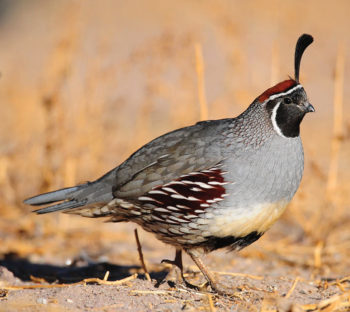 Linda Bolon
Linda Bolon
Gambel’s Quail is a member of the pheasant family. The male averages about six ounces. Females average between 5.7 and 5.9 ounces. They can attain speeds of up to 14 mph and they can fly as fast as 35 mph.
Although the Gambel’s have forward tilting plumes that end in a comma shape, the male can be identified by its russet crown, chestnut sides, lack of scaling on its under parts, dark forehead, black throat and black patch on his belly. The female is drabber in appearance and lacks her mate’s distinctive head markings and black belly patch and displays russet flanks slashed with white.
As nesting season approaches insects are increasingly fed upon, particularly ants. When the chicks arrive they are fed an almost pure insect diet. The leaves and seeds of mesquites and white-thorn acacia are also consumed along with cactus seeds and fruits, mimosa, wild mustard and climbing morning glory. Various beetles, leafhoppers and grasshoppers are also eaten but few summer annuals and almost no grasses are eaten during the summer months. Quail will regularly digest sand, grit and tiny pebbles to help their crops crush food and aid in the digestion process.
Coveys usually consist of single family groups. A typical clutch is ten to twelve eggs. In drought years, clutches can be as small as five or less. In wet years clutches of 20 have been recorded.
The nest is not much more than a shallow depression scraped into the ground among thick, thorny vegetation. It may be bordered by small twigs and sparsely lined with grass stems and a few feathers. Tree nests are occasionally constructed where suitable platforms can be found from five to 30 feet above the ground. Sometimes Quail will reuse an abandoned Cactus Wren grass nest or a thrasher’s stick nest, both usually found in prickly pear and Cholla cacti.
Adult males and females share in the parenting of the young birds. While the female incubates the eggs, the male guards the nest and brings food. If the female is taken or dies, the male assumes the duties of both parents. Parents almost always have a monogamous relationship which lasts their entire lifetime. If predation rates are high and overall favorable conditions exist, the pair rebrood.
The major threats to quail populations are the effects of man and climatic factors. Hunting and habitat fragmentation and loss due to human sprawl take their toll on the overall population.
Bobcats, mountain lions, coyotes and Coopers Hawks certainly take their share. Roadrunners enjoy hunting baby quail. The most significant predators are the egg-robbing cotton rats, round-tailed ground squirrels and snakes (the coachwhip, gopher and king snakes). Gila monsters are known to rob the nest of its eggs.
Ants can and do invade nest with eggs and young. Ants may be responsible for more predation than all other causes combined. In urban areas, domestic and feral cats also hunt quail and in agricultural areas pesticides can sometime take an alarming toll on the quail population.
